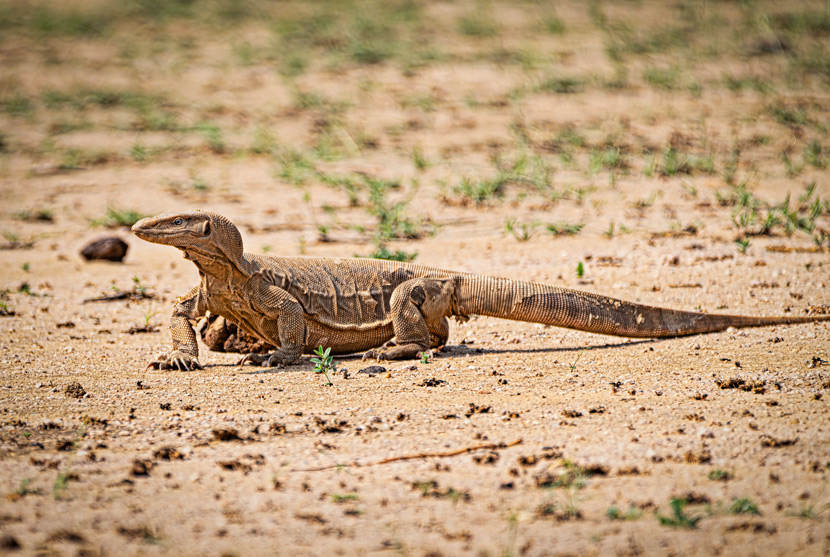It was quite a sight. About six feet long, weighing about 40 kg, a huge monitor lizard was clinging to the wall of the boundary pillar. A fully grown monitor with its scaly grey skin, long tail, clawed feet and flickering tongue looks exactly like a direct descendant of the dinosaurs.
This was the biggest monitor lizard we had seen in Sultanpur in Gurgaon. Earlier, we had seen the huge monitor lizards in the landscape of the Thar desert in Rajasthan.
The “sight” reminded me of the story of the great Maratha warrior Chatrapati Shivaji who used ‘ghorpad’ (monitor lizard) to scale the huge wall of the Sinhagad Fort. According to Maratha legends and folklore, a monitor lizard was used to scale to fortify walls of Sinhagad fort during a decisive battle. Shivaji’s trusted commander, Tanaji Malusare used these lizards in the Battle of Sinhagad in 1679. This battle is one of the important chapters of Maratha history.

Legends say that Tanaji used Shivaji’s pet monitor lizard Yashwanti to climb the fort wall. He tied a rope to the back of the lizard which scaled a sheer cliff face beneath an unguarded section of the fort, secured itself in a crevice, and allowed Tanaji to climb up behind. Though the assault was successful, Tanaji died in the battle.
When Shivaji heard of Tanaji's death, he said, "gad aala pan sinh gela" (the fort is captured, but the lion is gone). Shivaji renamed the fort as Sinhagad.
The monitor is an excellent climber, quite at home on trees or rocky cliffs, and an adept swimmer. With unshakeable grip, they can climb walls and even steep mountains and trees without any support. In Hindi it is called goh (गोह) and according to legends, in medieval times they were part of every army’s warfare tactics. It is believed in those periods, soldiers used them to climb walls and capture impregnable forts with the help of these lizards.
While the legends related to monitor lizards are often debated, it's a fact that these reptiles are immensely strong and can easily support the weight of a rope and a man.

Monitor lizards are interesting in that they look like crocodiles but very similar to snakes, with their distinctive forked tongues that they use to detect scent molecules from the air. They also hiss when they feel threatened.
India is home to four species of monitor lizard–Bengal monitor or Indian monitor, water monitor, yellow monitor and desert monitor. Like most varanids, Bengal monitors use scent primarily as their main method of communication and perception. They “taste” the environment around them by constantly flicking their highly sensitive tongues while moving their head from side to side. Conflict between males, whether over food or mating, usually results in an initial investigation by acquiring each other's scents and intent. Conflict typically involves vocalization which is a hissing noise accompanied by the monitor inflating its upper body to appear larger. Tail-slapping and whipping is common behavior between males, and sometimes between females, to establish dominance. Encounters between males can lead to wrestling in which case both males stand on their hind legs and embrace each other while thrashing their heads and upper bodies.

Their varied diet consists largely of invertebrates and other small animals like insects, rats, toads, etc.
According to experts though monitor lizards are common and seen in many parts of India–from deserts to wet evergreen patches but there is very little knowledge about their behaviour and natural history. For instance, these lizards are non poisonous and are “friends” of the ecosystem but due to lack of awareness, they are killed out of fear.
The monitor lizards, which help control insect and rodent populations, are protected under the Indian law and an international treaty that bans trade deemed to threaten an animal’s survival. They are regularly poached and killed for its meat, blood and oil. Its genitals are sold as a charm or an aphrodisiac as well as cure for several ailments.The species is said to be a one-stop cure for every disease.
Lizard skin bags, wallets and shoes are all made from the skins of these poor animals. In some parts of India, drums and chambers of stringed instruments are made using their skins. The species is listed under the ‘Least Concern’ category on the International Union for Conservation of Nature Red List (IUCN) but its population is dwindling due to rampant poaching. Agencies have announced cash rewards for providing information about poaching and poachers.
Read More: Kingfisher: The Bird which Inspired a bullet train in Japan
Read More: Brilliant Agama – a rare gem in Thar’s treasure trove




















